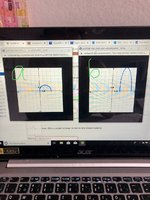I attached the picture of the graph for f(x) (marked with an a) and the graph for g(x) (marked with a b) .
The equation for graph:a is f(x) = sqrt(3x-x^2) with this i am supposed to find the equation for graph:b as g(x) = using the transformations of graph:a
My final answer was g(x) = 4 [sqrt(3x-x^2) -2]
I came to this answer because it looked like graph:a had been vertically stretched by 4 with a horizontal shift of 2 to the right. That answer was incorrect. I realized i probably have to factor the equation for f(x) out somehow which brought me to f(x) = sqrt(x(3-x)) but i'm not sure where i could go from there to obtain the equation for g(x).
i'm comfortable with transforming graphs that have a function with an equation that contains only a square root or only x^2. But i'm lost on where to begin with equations that combine those two.
Thank you for any help!
The equation for graph:a is f(x) = sqrt(3x-x^2) with this i am supposed to find the equation for graph:b as g(x) = using the transformations of graph:a
My final answer was g(x) = 4 [sqrt(3x-x^2) -2]
I came to this answer because it looked like graph:a had been vertically stretched by 4 with a horizontal shift of 2 to the right. That answer was incorrect. I realized i probably have to factor the equation for f(x) out somehow which brought me to f(x) = sqrt(x(3-x)) but i'm not sure where i could go from there to obtain the equation for g(x).
i'm comfortable with transforming graphs that have a function with an equation that contains only a square root or only x^2. But i'm lost on where to begin with equations that combine those two.
Thank you for any help!

